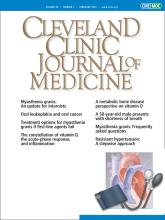ABSTRACT
Myasthenia gravis is a disorder of neuromuscular junction transmission, the result of antibodies against the post-synaptic aspect of the neuromuscular junction. Its clinical hallmark is fatigable weakness of skeletal muscles, which tends to vary in location and severity among patients. It is treated with pyridostigmine, immunotherapy, and thymectomy. Treatment is often individualized according to disease severity, antibody status, comorbidities, and other factors. This review uses a question-and-answer format to provide up-to-date, high-yield, clinically relevant information on myasthenia gravis.
- Copyright © 2023 The Cleveland Clinic Foundation. All Rights Reserved.
- John A. Morren, MD
- Yuebing Li, MD, PhD⇑
- Neuromuscular Center, Department of Neurology, Neurological Institute, Cleveland Clinic, Cleveland, OH; Professor, Cleveland Clinic Lerner College of Medicine of Case Western Reserve University, Cleveland, OH
- Address:
Yuebing Li, MD, PhD, Neurological Institute, S90, Cleveland Clinic, 9500 Euclid Avenue, Cleveland, OH 44195; Liy{at}ccf.org
ABSTRACT
Myasthenia gravis is a disorder of neuromuscular junction transmission, the result of antibodies against the post-synaptic aspect of the neuromuscular junction. Its clinical hallmark is fatigable weakness of skeletal muscles, which tends to vary in location and severity among patients. It is treated with pyridostigmine, immunotherapy, and thymectomy. Treatment is often individualized according to disease severity, antibody status, comorbidities, and other factors. This review uses a question-and-answer format to provide up-to-date, high-yield, clinically relevant information on myasthenia gravis.
- Copyright © 2023 The Cleveland Clinic Foundation. All Rights Reserved.






